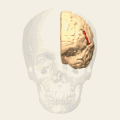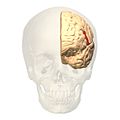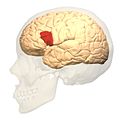Brodmann area 44: Difference between revisions
Rescuing 1 sources and tagging 0 as dead. #IABot (v1.2.7) |
replaced rotten reference and added new one |
||
| Line 29: | Line 29: | ||
==Functions== |
==Functions== |
||
Together with left-hemisphere [[Brodmann area 45|BA 45]], the left hemisphere<ref>In 95.5% of right-handers and 61.4% of left-handers, therefore about 92% of the clinical population, speech is [[Lateralization|lateralised]] in the left hemisphere.</ref> BA 44 comprises [[Broca's area]] a region involved in semantic tasks. Some data suggest that BA44 is more involved in phonological and syntactic processing. Some recent findings also suggest the implication of this region in [[music cognition|music perception]].<ref name="brown">{{cite journal | url= |
Together with left-hemisphere [[Brodmann area 45|BA 45]], the left hemisphere<ref>In 95.5% of right-handers and 61.4% of left-handers, therefore about 92% of the clinical population, speech is [[Lateralization|lateralised]] in the left hemisphere.</ref> BA 44 comprises [[Broca's area]] a region involved in semantic tasks. Some data suggest that BA44 is more involved in phonological and syntactic processing<ref>{{cite journal | url=http://pubman.mpdl.mpg.de/pubman/item/escidoc:727452/component/escidoc:727451/heim_theroleof.pdf | title=The role of the left Brodmann's areas 44 and 45 in reading words and pseudowords |author=Stefan Heima|author2= Kai Alterd|author3= Anja K. Ischebecke|author4= Katrin Amuntsa|author5= Simon B. Eickhoff|author6= Hartmut Mohlberga|author7= Karl Zillesa|author8= D. Yves von Cramonc|author9= Angela D. Friedericic | journal=Cognitive Brain Research | year=2005 | volume=25 | doi=10.1016/j.cogbrainres.2005.09.022 }}</ref>. Some recent findings also suggest the implication of this region in [[music cognition|music perception]].<ref name="brown">{{cite journal | url=https://pdfs.semanticscholar.org/e766/d77413582e0114410fa217eaaabe3ad1726f.pdf | title=Music and language side by side in the brain: a PET study of the generation of melodies and sentences |author1=Brown, Steven |author2=Michael J. Martinez |author3=Lawrence M. Parsons |last-author-amp=yes | journal=European Journal of Neuroscience | year=2006 | volume=23 | pages=2791–2803 | doi=10.1111/j.1460-9568.2006.04785.x | pmid=16817882}}</ref> |
||
Recent neuroimaging studies show BA44 involvement in selective response suppression in go/no- go tasks and is therefore believed to play an important role in the suppression of response tendencies.<ref>Forstmann, Birte U.; Van den Wildenberg, Wery P.M. and Ridderinkhof, Richard K (2008). Neural Mechanisms, Temporal Dynamics, and Individual Differences in Interference Control. ''Journal of Cognitive Neuroscience'' 20:10, pp. 1854-65.</ref> |
Recent neuroimaging studies show BA44 involvement in selective response suppression in go/no- go tasks and is therefore believed to play an important role in the suppression of response tendencies.<ref>Forstmann, Birte U.; Van den Wildenberg, Wery P.M. and Ridderinkhof, Richard K (2008). Neural Mechanisms, Temporal Dynamics, and Individual Differences in Interference Control. ''Journal of Cognitive Neuroscience'' 20:10, pp. 1854-65.</ref> |
||
Neuroimaging studies also demonstrate that area 44 is related to hand movements.<ref>{{cite journal|author1=Rizzolatti, G. |author2=Fogassi, L. |author3= Gallese, V. |title=Motor and cognitive functions of the ventral premotor cortex|journal=Current Opinion in Neurobiology|year=2002|volume=12|pages=149–154|url=http://www.sciencedirect.com/science/article/pii/S0959438802003082|accessdate=10 October 2013|doi=10.1016/S0959-4388(02)00308-2}}</ref> |
Neuroimaging studies also demonstrate that area 44 is related to hand movements.<ref>{{cite journal|author1=Rizzolatti, G. |author2=Fogassi, L. |author3= Gallese, V. |title=Motor and cognitive functions of the ventral premotor cortex|journal=Current Opinion in Neurobiology|year=2002|volume=12|pages=149–154|url=http://www.sciencedirect.com/science/article/pii/S0959438802003082|accessdate=10 October 2013|doi=10.1016/S0959-4388(02)00308-2}}</ref> |
||
Revision as of 07:19, 1 February 2017
| Brodmann area 44 | |
|---|---|
 | |
 | |
| Details | |
| Identifiers | |
| Latin | Area opercularis |
| NeuroLex ID | birnlex_1776 |
| FMA | 68641 |
| Anatomical terms of neuroanatomy | |
Brodmann area 44, or BA44, is part of the frontal cortex in the human brain. Situated just anterior to premotor cortex (BA6) and on the lateral surface, inferior to BA9.
This area is also known as pars opercularis (of the inferior frontal gyrus), and it refers to a subdivision of the cytoarchitecturally defined frontal region of cerebral cortex. In the human it corresponds approximately to the opercular part of inferior frontal gyrus (H). Thus, it is bounded caudally by the inferior precentral sulcus (H) and rostrally by the anterior ascending limb of lateral sulcus (H). It surrounds the diagonal sulcus (H). In the depth of the lateral sulcus it borders on the insula. Cytoarchitectonically it is bounded caudally and dorsally by the agranular frontal area 6, dorsally by the granular frontal area 9 and rostrally by the triangular area 45 (Brodmann-1909).
Functions
Together with left-hemisphere BA 45, the left hemisphere[1] BA 44 comprises Broca's area a region involved in semantic tasks. Some data suggest that BA44 is more involved in phonological and syntactic processing[2]. Some recent findings also suggest the implication of this region in music perception.[3] Recent neuroimaging studies show BA44 involvement in selective response suppression in go/no- go tasks and is therefore believed to play an important role in the suppression of response tendencies.[4] Neuroimaging studies also demonstrate that area 44 is related to hand movements.[5]
Trivia
Scott Flansburg of San Diego, California is a "human calculator" who can perform complex arithmetic in his head. Profiled on the TV show Stan Lee's Superhumans, his brain was scanned using fMRI while doing complex calculations, which showed brain activity in this region was absent. Instead there was activity somewhat higher from area 44 and closer to the motor cortex.[6][citation needed]
Image
-
Animation.
-
Frontal view.
-
Lateral view.
See also
Notes and references
- ^ In 95.5% of right-handers and 61.4% of left-handers, therefore about 92% of the clinical population, speech is lateralised in the left hemisphere.
- ^ Stefan Heima; Kai Alterd; Anja K. Ischebecke; Katrin Amuntsa; Simon B. Eickhoff; Hartmut Mohlberga; Karl Zillesa; D. Yves von Cramonc; Angela D. Friedericic (2005). "The role of the left Brodmann's areas 44 and 45 in reading words and pseudowords" (PDF). Cognitive Brain Research. 25. doi:10.1016/j.cogbrainres.2005.09.022.
- ^ Brown, Steven; Michael J. Martinez; Lawrence M. Parsons (2006). "Music and language side by side in the brain: a PET study of the generation of melodies and sentences" (PDF). European Journal of Neuroscience. 23: 2791–2803. doi:10.1111/j.1460-9568.2006.04785.x. PMID 16817882.
{{cite journal}}: Unknown parameter|last-author-amp=ignored (|name-list-style=suggested) (help) - ^ Forstmann, Birte U.; Van den Wildenberg, Wery P.M. and Ridderinkhof, Richard K (2008). Neural Mechanisms, Temporal Dynamics, and Individual Differences in Interference Control. Journal of Cognitive Neuroscience 20:10, pp. 1854-65.
- ^ Rizzolatti, G.; Fogassi, L.; Gallese, V. (2002). "Motor and cognitive functions of the ventral premotor cortex". Current Opinion in Neurobiology. 12: 149–154. doi:10.1016/S0959-4388(02)00308-2. Retrieved 10 October 2013.
- ^ "Electro Man: Episode 101". Stan Lee's Superhumans. August 5, 2011.
External links
- For Neuroanatomy of this area visit BrainInfo


